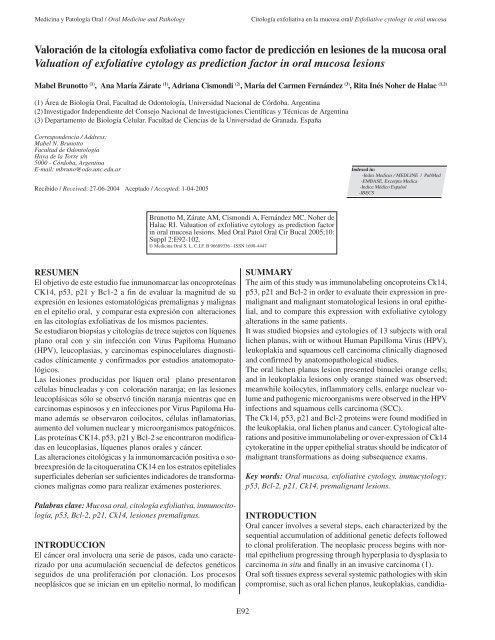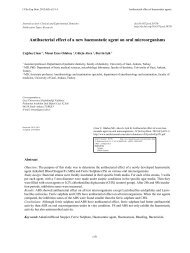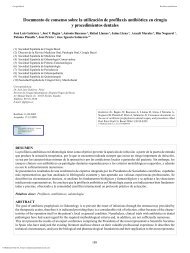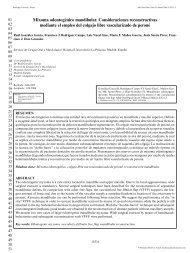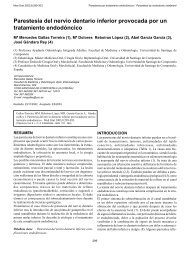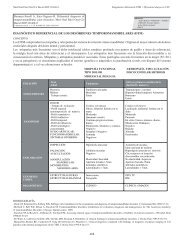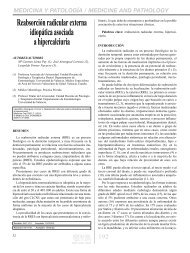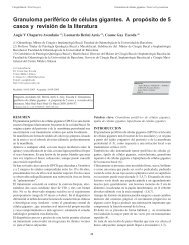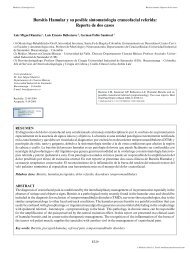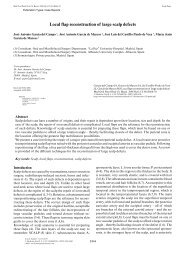Valoración de la citología exfoliativa como factor ... - Medicinaoral.com
Valoración de la citología exfoliativa como factor ... - Medicinaoral.com
Valoración de la citología exfoliativa como factor ... - Medicinaoral.com
Create successful ePaper yourself
Turn your PDF publications into a flip-book with our unique Google optimized e-Paper software.
Medicina y Patología Oral / Oral Medicine and Pathology Citología <strong>exfoliativa</strong> en <strong>la</strong> mucosa oral/ Exfoliative cytology in oral mucosa<br />
<strong>Valoración</strong> <strong>de</strong> <strong>la</strong> <strong>citología</strong> <strong>exfoliativa</strong> <strong><strong>com</strong>o</strong> <strong>factor</strong> <strong>de</strong> predicción en lesiones <strong>de</strong> <strong>la</strong> mucosa oral<br />
Valuation of exfoliative cytology as prediction <strong>factor</strong> in oral mucosa lesions<br />
Mabel Brunotto (1) , Ana María Zárate (1) , Adriana Cismondi (2) , María <strong>de</strong>l Carmen Fernán<strong>de</strong>z (3) , Rita Inés Noher <strong>de</strong> Ha<strong>la</strong>c (1,2)<br />
(1) Área <strong>de</strong> Biología Oral, Facultad <strong>de</strong> Odontología, Universidad Nacional <strong>de</strong> Córdoba. Argentina<br />
(2) Investigador In<strong>de</strong>pendiente <strong>de</strong>l Consejo Nacional <strong>de</strong> Investigaciones Científi cas y Técnicas <strong>de</strong> Argentina<br />
(3) Departamento <strong>de</strong> Biología Celu<strong>la</strong>r. Facultad <strong>de</strong> Ciencias <strong>de</strong> <strong>la</strong> Universidad <strong>de</strong> Granada. España<br />
Correspon<strong>de</strong>ncia / Address:<br />
Mabel N. Brunotto<br />
Facultad <strong>de</strong> Odontología<br />
Haya <strong>de</strong> <strong>la</strong> Torre s/n<br />
5000 - Córdoba, Argentina<br />
E-mail: mbruno@odo.unc.edu.ar<br />
Recibido / Received: 27-06-2004 Aceptado / Accepted: 1-04-2005<br />
RESUMEN<br />
El objetivo <strong>de</strong> este estudio fue inmunomarcar <strong>la</strong>s oncoproteínas<br />
CK14, p53, p21 y Bc1-2 a fin <strong>de</strong> evaluar <strong>la</strong> magnitud <strong>de</strong> su<br />
expresión en lesiones estomatológicas premalignas y malignas<br />
en el epitelio oral, y <strong>com</strong>parar esta expresión con alteraciones<br />
en <strong>la</strong>s <strong>citología</strong>s <strong>exfoliativa</strong>s <strong>de</strong> los mismos pacientes.<br />
Se estudiaron biopsias y <strong>citología</strong>s <strong>de</strong> trece sujetos con líquenes<br />
p<strong>la</strong>no oral con y sin infección con Virus Papiloma Humano<br />
(HPV), leucop<strong>la</strong>sias, y carcinomas espinocelu<strong>la</strong>res diagnosticados<br />
clínicamente y confirmados por estudios anatomopatológicos.<br />
Las lesiones producidas por líquen oral p<strong>la</strong>no presentaron<br />
célu<strong>la</strong>s binucleadas y con coloración naranja; en <strong>la</strong>s lesiones<br />
leucoplásicas sólo se observó tinción naranja mientras que en<br />
carcinomas espinosos y en infecciones por Virus Papiloma Humano<br />
a<strong>de</strong>más se observaron coilocitos, célu<strong>la</strong>s inf<strong>la</strong>matorias,<br />
aumento <strong>de</strong>l volumen nuclear y microorganismos patogénicos.<br />
Las proteínas CK14, p53, p21 y Bcl-2 se encontraron modificadas<br />
en leucop<strong>la</strong>sias, líquenes p<strong>la</strong>nos orales y cáncer.<br />
Las alteraciones citológicas y <strong>la</strong> inmunomarcación positiva o sobreexpresión<br />
<strong>de</strong> <strong>la</strong> citoqueratina CK14 en los estratos epiteliales<br />
superficiales <strong>de</strong>berían ser suficientes indicadores <strong>de</strong> transformaciones<br />
malignas <strong><strong>com</strong>o</strong> para realizar exámenes posteriores.<br />
Pa<strong>la</strong>bras c<strong>la</strong>ve: Mucosa oral, <strong>citología</strong> <strong>exfoliativa</strong>, inmuno<strong>citología</strong>,<br />
p53, Bcl-2, p21, Ck14, lesiones premalignas.<br />
INTRODUCCION<br />
El cáncer oral involucra una serie <strong>de</strong> pasos, cada uno caracterizado<br />
por una acumu<strong>la</strong>ción secuencial <strong>de</strong> <strong>de</strong>fectos genéticos<br />
seguidos <strong>de</strong> una proliferación por clonación. Los procesos<br />
neoplásicos que se inician en un epitelio normal, lo modifican<br />
Brunotto M, Zárate AM, Cismondi A, Fernán<strong>de</strong>z MC, Noher <strong>de</strong><br />
Ha<strong>la</strong>c RI. Valuation of exfoliative cytology as prediction <strong>factor</strong><br />
in oral mucosa lesions. Med Oral Patol Oral Cir Bucal 2005;10:<br />
Suppl 2:E92-102.<br />
© Medicina Oral S. L. C.I.F. B 96689336 - ISSN 1698-4447<br />
E92<br />
In<strong>de</strong>xed in:<br />
-In<strong>de</strong>x Medicus / MEDLINE / PubMed<br />
-EMBASE, Excerpta Medica<br />
-Indice Médico Español<br />
-IBECS<br />
SUMMARY<br />
The aim of this study was immuno<strong>la</strong>beling oncoproteins Ck14,<br />
p53, p21 and Bcl-2 in or<strong>de</strong>r to evaluate their expression in premalignant<br />
and malignant stomatological lesions in oral epithelial,<br />
and to <strong>com</strong>pare this expression with exfoliative cytology<br />
alterations in the same patients.<br />
It was studied biopsies and cytologies of 13 subjects with oral<br />
lichen p<strong>la</strong>nus, with or without Human Papilloma Virus (HPV),<br />
leukop<strong>la</strong>kia and squamous cell carcinoma clinically diagnosed<br />
and confirmed by anatomopathological studies.<br />
The oral lichen p<strong>la</strong>nus lesion presented binuclei orange cells;<br />
and in leukop<strong>la</strong>kia lesions only orange stained was observed;<br />
meanwhile koilocytes, inf<strong>la</strong>mmatory cells, en<strong>la</strong>rge nuclear volume<br />
and pathogenic microorganisms were observed in the HPV<br />
infections and squamous cells carcinoma (SCC).<br />
The Ck14, p53, p21 and Bcl-2 proteins were found modified in<br />
the leukop<strong>la</strong>kia, oral lichen p<strong>la</strong>nus and cancer. Cytological alterations<br />
and positive immuno<strong>la</strong>beling or over-expression of Ck14<br />
cytokeratine in the upper epithelial stratus should be indicator of<br />
malignant transformations as doing subsequence exams.<br />
Key words: Oral mucosa, exfoliative cytology, immucytology;<br />
p53, Bcl-2, p21, Ck14, premalignant lesions.<br />
INTRODUCTION<br />
Oral cancer involves a several steps, each characterized by the<br />
sequential accumu<strong>la</strong>tion of additional genetic <strong>de</strong>fects followed<br />
to clonal proliferation. The neop<strong>la</strong>sic process begins with normal<br />
epithelium progressing through hyperp<strong>la</strong>sia to dysp<strong>la</strong>sia to<br />
carcinoma in situ and finally in an invasive carcinoma (1).<br />
Oral soft tissues express several systemic pathologies with skin<br />
<strong>com</strong>promise, such as oral lichen p<strong>la</strong>nus, leukop<strong>la</strong>kias, candidia-
Med Oral Patol Oral Cir Bucal 2005;Suppl 2:E92-102. Citología <strong>exfoliativa</strong> en <strong>la</strong> mucosa oral / Exfoliative cytology in oral mucosa<br />
a un epitelio hiperplásico, displásico, carcinoma in situ y finalmente<br />
en un carcinoma invasivo (1).<br />
Los tejidos b<strong>la</strong>ndos <strong>de</strong> <strong>la</strong> boca manifiestan una variedad <strong>de</strong><br />
patologías sistémicas con <strong>com</strong>promiso cutáneo, entre el<strong>la</strong>s se<br />
encuentran lesiones <strong><strong>com</strong>o</strong> líquenes orales p<strong>la</strong>nos, leucop<strong>la</strong>sias,<br />
candidiasis, queratosis, papilomas, úlceras traumáticas, infecciones<br />
por HPV, entre otros (2). Las leucop<strong>la</strong>sias y líquenes, con<br />
y sin infección con HPV, constituyen lesiones frecuentes <strong>de</strong> <strong>la</strong><br />
mucosa bucal con características premalignas o precancerosas<br />
(3-5). Las leucop<strong>la</strong>sias pue<strong>de</strong>n transformarse en carcinomas en<br />
un 1-10% y los líquenes en un 5%, <strong>de</strong>pendiendo <strong>de</strong>l sitio <strong>de</strong><br />
ataque y <strong>de</strong>l grado <strong>de</strong> disp<strong>la</strong>sia epitelial observado (6)<br />
La transformación maligna en <strong>la</strong> cavidad oral <strong>de</strong>pen<strong>de</strong> en cierto<br />
modo <strong>de</strong>l sitio anatómico que se ve afectado (<strong>la</strong>bios, lengua,<br />
piso <strong>de</strong> <strong>la</strong> boca, pa<strong>la</strong>dar, gingiva, mucosa bucal y orofaringe),<br />
<strong>de</strong> los numerosos <strong>factor</strong>es endógenos y exógenos que afectan el<br />
crecimiento <strong>de</strong> <strong>la</strong>s célu<strong>la</strong>s malignas en cada uno <strong>de</strong> estos sitios<br />
y <strong>de</strong> <strong>la</strong> re<strong>la</strong>ción con el suministro <strong>de</strong> nutrientes (7).<br />
Varias investigaciones prueban que <strong>la</strong> expresión <strong>de</strong> proteínas<br />
<strong><strong>com</strong>o</strong> p53, Bcl-2, p21, p21 waf , Bax, citoqueratinas, que están<br />
involucradas en procesos <strong><strong>com</strong>o</strong> proliferación celu<strong>la</strong>r (8), diferenciación<br />
celu<strong>la</strong>r (9) y apoptosis (10) presentan modificaciones<br />
en re<strong>la</strong>ción a <strong>la</strong> carcinogénesis en el epitelio <strong>de</strong> <strong>la</strong> mucosa oral.<br />
La oncoproteína Bcl-2 está re<strong>la</strong>cionada con <strong>la</strong> inhibición <strong>de</strong> <strong>la</strong><br />
apoptosis (11). La proteína CK14 es reconocida <strong><strong>com</strong>o</strong> un marcador<br />
específico <strong>de</strong> <strong>la</strong> diferenciación celu<strong>la</strong>r en <strong>la</strong>s capas <strong>de</strong>l estrato<br />
basal <strong>de</strong> un epitelio normal estratificado (12). La proteína p53<br />
inhibe <strong>la</strong> progresión <strong>de</strong>l ciclo celu<strong>la</strong>r, regu<strong>la</strong>ndo el crecimiento<br />
celu<strong>la</strong>r y promoviendo <strong>la</strong> apoptosis <strong>de</strong> célu<strong>la</strong>s con ADN dañado<br />
(13). La familia <strong>de</strong> proteínas p21, codificada por los genes ras,<br />
está ligada a <strong>la</strong> transducción <strong>de</strong> señales. La expresión <strong>de</strong> estas<br />
oncoproteínas fue estudiada in situ en varios tejidos orales por<br />
medio <strong>de</strong> inmunocitoquímica (14-20).<br />
Los cambios morfo-fisiológicos pue<strong>de</strong>n ser <strong>de</strong>tectados por medio<br />
<strong>de</strong> metodologías <strong>de</strong> monitoreo <strong><strong>com</strong>o</strong> <strong>citología</strong> <strong>exfoliativa</strong> y/o<br />
por inmunomarción in situ con anticuerpos contra proteínas<br />
<strong><strong>com</strong>o</strong> <strong>la</strong>s mencionadas anteriormente. Por otra parte, <strong>la</strong> utilidad<br />
<strong>de</strong> los extendidos citológicos <strong>de</strong> mucosa oral, que pue<strong>de</strong>n<br />
ser obtenidos en forma no invasiva, para <strong>la</strong> caracterización <strong>de</strong>l<br />
riesgo oncogénico en <strong>la</strong> cavidad oral, aún no se ha establecido<br />
fehacientemente, tal <strong><strong>com</strong>o</strong> se ha realizado en el caso <strong>de</strong>l cáncer<br />
<strong>de</strong> útero en pacientes ginecológicos mediante <strong>la</strong> tinción <strong>de</strong> Papanico<strong>la</strong>u<br />
(PAP) (21).<br />
Esta metodología es utilizada en programas preventivos <strong>de</strong> salud<br />
pública a fin <strong>de</strong> evaluar riesgo <strong>de</strong> cáncer genital en <strong>la</strong> pob<strong>la</strong>ción.<br />
En mucosa oral, <strong>la</strong> <strong>citología</strong> <strong>exfoliativa</strong> (CE) reve<strong>la</strong> alteraciones<br />
morfo-fisiológicas (22) en <strong>la</strong>s célu<strong>la</strong>s epiteliales, tales <strong><strong>com</strong>o</strong><br />
cambios en el tamaño nuclear y aspecto sucio <strong>de</strong>l preparado, los<br />
cuales ayudan a un diagnóstico presuntivo (23). Sin embargo,<br />
esta metodología no invasiva y <strong>de</strong> bajo costo no es utilizada<br />
actualmente <strong><strong>com</strong>o</strong> monitoreo <strong>de</strong> lesiones en mucosa oral en los<br />
programas <strong>de</strong> salud pública en nuestro país.<br />
El objetivo <strong>de</strong> este estudio fue inmunomarcar <strong>la</strong>s oncoproteínas<br />
CK14, p53, p21 y Bcl-2 a fin <strong>de</strong> evaluar <strong>la</strong> magnitud <strong>de</strong> su<br />
expresión en lesiones estomatológicas premalignas y malignas<br />
en el epitelio oral <strong>de</strong> pacientes, y <strong>com</strong>parar esta expresión<br />
con alteraciones en <strong>la</strong>s <strong>citología</strong>s <strong>exfoliativa</strong>s <strong>de</strong> los mismos<br />
E93<br />
sis, keratosis, papillomas, traumatic ulcer, and HPV infections,<br />
among others (2). Leukop<strong>la</strong>kia and oral lichen p<strong>la</strong>nus, with<br />
and without HPV infections, are frequent lesions of buccal<br />
mucosa with premalignant and precancerous features (3-5).<br />
Leukop<strong>la</strong>kias can transform into carcinomas in 1-10% and<br />
lichens in 5%, <strong>de</strong>pending on attack site or epithelial dysp<strong>la</strong>sic<br />
gra<strong>de</strong> observed (6).<br />
The malignant transformation in oral cavity some way <strong>de</strong>pends<br />
on affected anatomic site (lips, tongue, mouth floor, pa<strong>la</strong>te, gingiva,<br />
buccal mucosa and oropharynx), endogenous and exogenous<br />
<strong>factor</strong>s that affect malignant cell grow up into each sites and the<br />
re<strong>la</strong>tionship with nutrients supply (7).<br />
Various studies proved that the expression of proteins, like p53,<br />
Bcl-2, p21, p21 waf , Bax, cytoqueratins, etc., that affect processes<br />
such as cell proliferation (8), cell differentiation (9) and<br />
apoptosis (10) show changes in re<strong>la</strong>tion to carcinogenesis in<br />
the epithelial <strong>la</strong>yers of the oral mucosa. The oncoprotein Bcl-2<br />
was re<strong>la</strong>ted to the inhibition of apoptosis (11). CK14 protein is<br />
recognised as a specific marker for cell differentiation in the<br />
basal stratum of normal stratified epithelia (12). The protein<br />
p53 inhibited the progression of the cell cycle, regu<strong>la</strong>ting cell<br />
growth and promoting apoptosis in cells with damage DNA (13).<br />
The family of p21 proteins enco<strong>de</strong>d by ras genes is linked to<br />
the transduction of signals. The expression of these oncogenic<br />
proteins was studied in situ in various oral tissues by immunocytochemistry<br />
(14-20).<br />
The morpho-physiological changes could be <strong>de</strong>tected through<br />
screening methodology as exfoliative cytology and/or in situ<br />
immuno<strong>la</strong>beling with antibodies against proteins like mentioned<br />
before. In the other hand, useful of oral mucosa cytology smears,<br />
that can be obtained for non invasive way, for characterization<br />
of oncogenic risk in oral cavity, has not been reliably established<br />
like it has been performed in the case of uterus cancer in<br />
gynaecologic patients by PAP stained (21)<br />
This methodology is used in preventive programs of public<br />
health in or<strong>de</strong>r to evaluate genital cancer risk on popu<strong>la</strong>tion.<br />
In oral mucosa, the exfoliative cytology (EC) reveals morphophysiological<br />
alterations (22) in squamous cells like dirtiness<br />
of the smear and changes in the size of the nucleus, all of which<br />
may be used to aid as presumptive diagnostic (23). Nevertheless,<br />
this cheap, non invasive methodology is not used actually as<br />
a means of screening for lesions in the oral mucosa in public<br />
health programs in our country.<br />
The aim of this study was immuno<strong>la</strong>beling oncoproteins Ck14,<br />
p53, p21 and Bcl-2 in or<strong>de</strong>r to evaluate their expression in premalignant<br />
and malignant stomatological lesions in oral epithelial,<br />
and to <strong>com</strong>pare this expression with exfoliative cytology<br />
alterations in the same patients.<br />
MATERIAL AND METHOD<br />
Subjects: Forty-six subjects were studied, both sexes ranked 23<br />
to 75 years. Controls of cytolgies (n=23) and biopsy (n=10) were<br />
subjects diagnosed of healthy clinically oral mucosa. Patients<br />
were persons (n=13) with same ranked ages and sex as controls,<br />
from external office of the Faculty of Odontology, Cordoba National<br />
University. The study was performed according to legal<br />
norms of ethics <strong>la</strong>id down by the School of Dentistry, National
Medicina y Patología Oral / Oral Medicine and Pathology Citología <strong>exfoliativa</strong> en <strong>la</strong> mucosa oral/ Exfoliative cytology in oral mucosa<br />
pacientes.<br />
MATERIALES Y METODOS<br />
-Sujetos: Fueron estudiados cuarenta y seis sujetos <strong>de</strong> ambos<br />
sexos con rango <strong>de</strong> edad <strong>de</strong> 23 a 75 años. Los controles <strong>de</strong> <strong>citología</strong><br />
(n=23) y <strong>de</strong> biopsia (n=10) fueron sujetos con diagnóstico<br />
<strong>de</strong> mucosa oral clínicamente sana. Los pacientes fueron personas<br />
(n=13) <strong>de</strong>l mismo rango <strong>de</strong> edad y <strong>de</strong> sexos que los controles,<br />
que concurrieron al consultorio externo <strong>de</strong> <strong>la</strong> Facultad <strong>de</strong> Odontología<br />
<strong>de</strong> <strong>la</strong> Universidad Nacional <strong>de</strong> Córdoba. El estudio se<br />
llevó a cabo según <strong>la</strong>s normas legales vigentes <strong>de</strong> ética <strong>de</strong> <strong>la</strong><br />
Universidad Nacional <strong>de</strong> Córdoba, Argentina.<br />
Se incluyó a todos los sujetos que presentaban lesiones en mucosa<br />
oral con características clínicas consistentes con carcinomas,<br />
leucop<strong>la</strong>sias o líquenes orales p<strong>la</strong>nos, con y sin infección con<br />
HPV y que fueron confirmados por diagnóstico histopatológico<br />
a microscopía óptica por los profesionales estomatólogos y<br />
anatomopatólogos. La infección con Papiloma Virus Humano<br />
(HPV) fue corroborada por observación <strong>de</strong> <strong>la</strong>s partícu<strong>la</strong>s virales<br />
a microscopía electrónica.<br />
Los pacientes (n=13) fueron divididos en dos subgrupos <strong>de</strong><br />
acuerdo al diagnóstico anatomopatológico confirmado: a) pacientes<br />
con lesiones premalignas (leucop<strong>la</strong>sias o líquenes orales<br />
p<strong>la</strong>nos con y sin infección con HPV) (n=10) y b) pacientes con<br />
lesiones malignas (carcinoma in situ) (n=3).<br />
-Citología Exfoliativa: Se recolectaron célu<strong>la</strong>s <strong>de</strong> <strong>la</strong> mucosa oral<br />
directamente <strong>de</strong> <strong>la</strong>s lesiones y <strong>de</strong> <strong>la</strong> zona opuesta clínicamente<br />
sana, en el mismo paciente, por cepil<strong>la</strong>do (cytobrush-Galucci)<br />
y fueron procesadas con tinción <strong>de</strong> Papanico<strong>la</strong>u (PAP) (23).En<br />
los sujetos controles, <strong>la</strong>s <strong>citología</strong>s fueron obtenidas por cepil<strong>la</strong>do<br />
<strong>de</strong> mucosa oral no queratinizada perteneciente al carrillo,<br />
lengua y / o pa<strong>la</strong>dar. Después <strong>de</strong> <strong>la</strong> tinción con PAP (23) <strong>la</strong>s<br />
<strong>citología</strong>s fueron observadas en un microscopio Olympus BX50<br />
y analizadas con un software para análisis <strong>de</strong> imágenes, Image<br />
Pro Plus System.<br />
-Biopsias: Todas <strong>la</strong>s muestras fueron fijadas con una mezc<strong>la</strong><br />
<strong>de</strong> glutaral<strong>de</strong>hído 1% y parafomal<strong>de</strong>hído 4% en sym-collidine<br />
buffer 0.1 M pH 7.2 por 4 h a temperatura ambiente. A posterior<br />
fueron incluidas en Unicryl (BioCell, U.K.) y polimerizadas con<br />
UV 360 nm a 4ºC por 4-6 días. Se cortaron secciones semifinas<br />
(1µm) con un ultramicrótomo Reichert E y teñidas con azul <strong>de</strong><br />
metileno para MO. Los cortes ultrafinos (0.7-0.8 µm) fueron colocados<br />
en gril<strong>la</strong>s <strong>de</strong> níquel, 300 meshes, cubiertas con Formvar<br />
y contrastadas con acetato <strong>de</strong> uranilo y citrato <strong>de</strong> plomo.<br />
-Inmunocitoquímica: Los cortes ultrafinos fueron incubados toda<br />
<strong>la</strong> noche con IgM <strong>de</strong> ratón anti CK14 e IgG <strong>de</strong> ratón anti p53, p21<br />
y Bc1-2 (Sigma-Aldrich, USA) con una dilución 1:100 PBS, en<br />
cámara húmeda a 4ºC. El anticuerpo secundario IgM o IgG antiratón<br />
conjugado con partícu<strong>la</strong>s <strong>de</strong> oro coloidal <strong>de</strong> 5 ó 10 nm, con<br />
una dilución 1:50 en PBS (Sigma-Aldrich, USA) fue incubado<br />
por 2-3 hs a temperatura ambiente (23). Para MO se realizó un<br />
incremento con p<strong>la</strong>ta <strong>de</strong> acuerdo al protocolo <strong>de</strong> BioCell, U.K.<br />
Luego, los cortes fueron teñidos con hematoxilina-eosina o con<br />
safranina 10%. Para MET los cortes ultrafinos fueron tratados<br />
<strong>de</strong>l mismo modo sin incremento <strong>de</strong> p<strong>la</strong>ta. Los cortes fueron<br />
contrastados con acetato <strong>de</strong> uranilo 5%. La inmunomarcación<br />
E94<br />
University Cordoba Argentina.<br />
The study inclu<strong>de</strong>d all subjects that presented lesions in oral<br />
mucosa with clinical features consistent with squamous cell<br />
carcinoma; leukop<strong>la</strong>kia or oral lichen p<strong>la</strong>nus, with and without<br />
HPV confirmed light microscopy histopathological diagnostic<br />
by stomatologist and anatomopathologist. Human Papilloma<br />
Virus infection (HPV) was corroborated by the observations of<br />
viral particles at electron miscroscopy.<br />
The patients (n=13) were divi<strong>de</strong>d into two subgroups according<br />
confirmed anatomopathological diagnostic: a) patients with premalignant<br />
lesions (leukop<strong>la</strong>kias or oral lichen p<strong>la</strong>nus with and<br />
without HPV infection) (n=10) and b) patients with malignant<br />
lesions (carcinoma in situ) (n=3).<br />
-Exfoliative Cytology: Cells were collected with a cytobrush<br />
(Galucci) directly from lesions and from healthy tissue on the<br />
opposite si<strong>de</strong> of the same patient’s mouth and processed with Papanico<strong>la</strong>u<br />
stained (PAP) (23). In the control subjects, the smears<br />
were obtained brushing non keratinizated oral mucosa belongs<br />
to cheek, the tongue and/or pa<strong>la</strong>te. After staining with PAP (23)<br />
the smears were examined un<strong>de</strong>r an Olympus BX50 microscope<br />
and analyzed with software Image Pro plus System.<br />
-Biopsies: All samples were fixed in a mixture of glutaral<strong>de</strong>hy<strong>de</strong><br />
1% and paraformal<strong>de</strong>hy<strong>de</strong> 4% in sym-collidine buffer 0.1 M<br />
pH 7.2 for 4 h at RT. Then inclu<strong>de</strong>d in Unicryl (BioCell, U.K.)<br />
polymerized at 360 nm UV ligth at 4ºC for 4-6 days. Semithin<br />
sections (1 µm) were cut with a ReichertE ultramicrotome and<br />
stained with methylene blue for light microscopy. The ultrathin<br />
sections (0.7-0.8 µm) were collected on 300 meshes Formvar<br />
coated nickel grids and contrasted with lead citrate and uranyl<br />
acetate.<br />
-Immunocytochemistry: Semithin sections were incubated overnight<br />
with mouse IgM CK14 and mouse IgG p53, p21 and Bc12<br />
(Sigma-Aldrich, USA) in to 1:100 PBS, in a humid chamber at<br />
4ºC. The secondary mouse antibody, diluted 1:50 in PBS was<br />
IgM or IgG conjugated with 5 or 10 nm particles of colloidal<br />
gold (Sigma-Aldrich, USA) incubated for 2-3 h at RT (23).<br />
Silver enhancement was carried out according to the supplier’s<br />
instructions (BioCell, U.K.) by light microscopy. Then, sections<br />
were stained with hematoxylin-eosin or in safranine 10%.<br />
For TEM the ultrathin sections were treated as the same way<br />
without silver enhancement. The sections were contrasted with<br />
5% uraniyl acetate. Immuno<strong>la</strong>beling was evaluated by quantity<br />
of gold-silver/mm 2 particles in sections at light microscopy like<br />
negative (0 particles/mm 2 ) or positive (>20 particles/mm 2 ).<br />
-Statistical Analysis: immuno<strong>la</strong>beling was statistically evaluated<br />
with non parametric Mann-Whitney U test for in<strong>de</strong>pen<strong>de</strong>nts<br />
samples at confi<strong>de</strong>nce level estimated by bootstrap of 0.05%<br />
(samples sizes minus 10) with software SPSS 10.1 version by<br />
Windows, 1999.<br />
RESULTS<br />
In the cytology controls, PAP stained, were observed epithelial<br />
cells of oral mucosa, basophilic and acidophilic, with picnotic<br />
nuclei and nucleus to cytop<strong>la</strong>sm ratio 1:10 with “clean” background.<br />
Studied lesions were localized in different anatomical regions of
Med Oral Patol Oral Cir Bucal 2005;Suppl 2:E92-102. Citología <strong>exfoliativa</strong> en <strong>la</strong> mucosa oral / Exfoliative cytology in oral mucosa<br />
fue evaluada según <strong>la</strong> cantidad <strong>de</strong> partícu<strong>la</strong>s <strong>de</strong> oro-p<strong>la</strong>ta/ mm 2<br />
en los cortes <strong>de</strong> microscopía óptica <strong><strong>com</strong>o</strong> negativa (0 partícu<strong>la</strong>s/<br />
mm 2 ) o positiva (>20 partícu<strong>la</strong>s/ mm 2 )<br />
-Análisis Estadísticos: La inmunomarcación fue evaluada estadísticamente<br />
con el test no paramétrico Mann-Whitnney U para<br />
muestras in<strong>de</strong>pendientes con un nivel <strong>de</strong> confianza estimado por<br />
bootstrap <strong>de</strong> 0.05% (para muestras <strong>de</strong> tamaño menores a 10) con<br />
software SPSS 10.1 versión para Windows, 1999.<br />
RESULTADOS<br />
En los controles citológicos, teñidos con PAP, se observaron<br />
célu<strong>la</strong>s epiteliales <strong>de</strong> mucosa oral, basófi<strong>la</strong>s y acidófi<strong>la</strong>s, con<br />
núcleo picnótico y re<strong>la</strong>ción núcleo-citop<strong>la</strong>sma 1:10 y con fondo<br />
“limpio”.<br />
Las lesiones estudiadas se localizaron en diferentes regiones<br />
anatómicas <strong>de</strong> <strong>la</strong> cavidad oral (lengua, carrillo interno, pa<strong>la</strong>dar<br />
duro y b<strong>la</strong>ndo). Los líquenes orales p<strong>la</strong>nos mostraron, <strong><strong>com</strong>o</strong><br />
característica particu<strong>la</strong>r, célu<strong>la</strong>s naranjas al igual que <strong>la</strong>s leucop<strong>la</strong>sias<br />
don<strong>de</strong> todas <strong>la</strong>s célu<strong>la</strong>s presentaron esta coloración (Fig.<br />
1A). En los pacientes con carcinomas espinocelu<strong>la</strong>res <strong>la</strong>s CE<br />
teñidas con PAP mostraron aspecto “sucio”, aumento <strong>de</strong>l tamaño<br />
nuclear en re<strong>la</strong>ción al citop<strong>la</strong>sma 10:1. A MET <strong>la</strong>s biopsias<br />
<strong>de</strong> estos pacientes presentaron vacuolización citop<strong>la</strong>smática y<br />
<strong>de</strong>sorganización tisu<strong>la</strong>r. A MO en <strong>la</strong>s lesiones premalignas se<br />
observó disp<strong>la</strong>sia epitelial y membrana basal modificada.<br />
Las biopsias <strong>de</strong> controles sanos observadas a MO mostraron <strong>la</strong>s<br />
características histológicas normales <strong>de</strong>l epitelio estratificado no<br />
queratinizado. La inmunomarcación en <strong>la</strong>s muestras controles<br />
<strong>de</strong> p53, p21, Bcl-2 fue negativa mientras que <strong>la</strong> marcación con<br />
Ck14 fue positiva en el estrato basal epitelial.<br />
La inmunomarcación con Ck14 resultó positiva en los estratos<br />
superficiales <strong>de</strong> <strong>la</strong> mucosa oral <strong>de</strong> <strong>la</strong>s lesiones preneoplásicas y<br />
neoplásicas, y fue estadísticamente significativa con respecto a<br />
los controles (p
Medicina y Patología Oral / Oral Medicine and Pathology Citología <strong>exfoliativa</strong> en <strong>la</strong> mucosa oral/ Exfoliative cytology in oral mucosa<br />
Tab<strong>la</strong> 1. Citologías e inmunomarcación <strong>de</strong> mucosa oral <strong>de</strong> pacientes adultos con lesiones diagnosticadas estomatológica<br />
y anatomapatológicamente.<br />
A: Lesiones Premalignas<br />
N Sexo<br />
Rango<br />
<strong>de</strong><br />
Edad<br />
(años)<br />
Sitio <strong>de</strong><br />
lesión<br />
4 F-M 43 a 77 Lengua<br />
2 M 35 -43<br />
4 F-M 39-76<br />
B: Lesiones Malignas<br />
3 F-M 51-68<br />
C: Controles<br />
10 F-M 23-77<br />
Lengua y<br />
Pa<strong>la</strong>dar<br />
Yugal y Lengua<br />
Lengua y<br />
Pa<strong>la</strong>dar<br />
Lengua,<br />
Yugal y<br />
Pa<strong>la</strong>dar<br />
Diagnóstico<br />
Líquen Oral<br />
p<strong>la</strong>no<br />
Leucop<strong>la</strong>sia<br />
HPV y<br />
Líquen Oral<br />
p<strong>la</strong>no<br />
Carcinoma in<br />
situ<br />
Normal<br />
(*) Diferencias estadísticamente significativas con p
Med Oral Patol Oral Cir Bucal 2005;Suppl 2:E92-102. Citología <strong>exfoliativa</strong> en <strong>la</strong> mucosa oral / Exfoliative cytology in oral mucosa<br />
Table 1. Cytologies and immuno<strong>la</strong>beling of oral mucosa of adults patients with stomatological and<br />
anatomopathological diagnostic lesions.<br />
A: Premalignant lesions<br />
N Sex<br />
Age<br />
rank<br />
(ages)<br />
Lesion<br />
site<br />
4 F-M 43 - 77 Tongue<br />
2 M 35 -43<br />
4 F-M 39-76<br />
B: Malignant Lesions<br />
3 F-M 51-68<br />
C: Controls<br />
10 F-M 23-77<br />
Tongue<br />
and Pa<strong>la</strong>te<br />
Yugal and<br />
Tongue<br />
Tongue<br />
and Pa<strong>la</strong>te<br />
Tongue, Yugal<br />
and Pa<strong>la</strong>te<br />
(*) Significan statistical differences p
Medicina y Patología Oral / Oral Medicine and Pathology Citología <strong>exfoliativa</strong> en <strong>la</strong> mucosa oral/ Exfoliative cytology in oral mucosa<br />
E98<br />
Fig. 1. A) Leucop<strong>la</strong>sia: <strong>citología</strong> <strong>exfoliativa</strong>, (*)<br />
zona con queratinización. Tinción PAP, 320X<br />
B) Líquen oral p<strong>la</strong>no: Microscopía Optica, inmunomarcación<br />
oro-p<strong>la</strong>ta positiva <strong>de</strong> citoqueratina<br />
K14 (flecha), ES: estrato superficial; EB estrato<br />
basal; N: núcleo. Safranina 10%, 200X.<br />
C) Líquen oral p<strong>la</strong>no infectado con HPV: Microscopía<br />
electrónica <strong>de</strong> transmisión11.000X.<br />
co: coilocito; ck: citoesqueleto; n: núcleo; nu:<br />
nucleolo; <strong>de</strong>: <strong>de</strong>smosomas; membrana nuclear<br />
<strong>de</strong> forma irregu<strong>la</strong>r.<br />
A) Leukop<strong>la</strong>kia: exfoliative cytology (*) Keratinized<br />
area. PAP stained, 320X<br />
B) Oral Lichen P<strong>la</strong>nus: Light Microscopy, inmunomarked<br />
positive gold-silver of citoqueratine<br />
K14 (arrow), ES: upper stratus; EB basal stratus;<br />
N: nuclei. Safranine 10%, 200X.<br />
C) Oral Lichen P<strong>la</strong>nus infected with HPV:<br />
Transmission Electron Microscopy 11.000X.<br />
co: koilocyto; ck: cytosqueleton; n: nuclei;<br />
nu: nucleolus; <strong>de</strong>: <strong>de</strong>smosomes;irregu<strong>la</strong>r<br />
membrane nuclear.
Med Oral Patol Oral Cir Bucal 2005;Suppl 2:E92-102. Citología <strong>exfoliativa</strong> en <strong>la</strong> mucosa oral / Exfoliative cytology in oral mucosa<br />
* Orangiofilia<br />
* Célu<strong>la</strong>s binucleadas<br />
* Núcleos agrandados<br />
* Fondo sucio<br />
* Coilocitos<br />
R= 1 - 4<br />
BIOPSIA<br />
Diagnóstico anátomo-<br />
patológico<br />
Cáncer<br />
Leucop<strong>la</strong>sia<br />
Liquen<br />
HPV<br />
TIPIFICACIÓN DEL<br />
VIRUS<br />
P21<br />
(+) (-)<br />
R = 4 R = 2<br />
Bcl2<br />
(+) (-)<br />
R = 3 R = 2<br />
CITOLOGÍA<br />
Fig. 2. Algoritmo <strong>de</strong> riesgo carcinogénico; R, riesgo, esca<strong>la</strong> <strong>de</strong> 1 a 4 según el número <strong>de</strong> biomarcadores positivos y características<br />
<strong>de</strong> <strong>la</strong>s <strong>citología</strong>s <strong>exfoliativa</strong>s.<br />
E99<br />
* Célu<strong>la</strong>s azules y rojas<br />
* Uninucleadas<br />
* Nucleos no agrandados<br />
* Fondo limpio<br />
NORMAL R= 0<br />
(Controles)<br />
INMUNOCITOQUÍMICA<br />
CK14<br />
(+) R = 1 (-) R = 0<br />
(Controles)<br />
P53<br />
(+) R = 2 (-) R = 1<br />
P21<br />
(+) (-)<br />
R = 3 R = 2<br />
P21<br />
(+) (-)<br />
R = 3 R = 2<br />
Bcl2<br />
(+) (-)<br />
R = 2 R = 1<br />
P21<br />
(+) (-)<br />
R = 2 R = 2
Medicina y Patología Oral / Oral Medicine and Pathology Citología <strong>exfoliativa</strong> en <strong>la</strong> mucosa oral/ Exfoliative cytology in oral mucosa<br />
* Orangiofilia<br />
* Binucleate Cells<br />
* En<strong>la</strong>rgement nucleus<br />
* Dirty background<br />
* Koylocytes<br />
R= 1 - 4<br />
BIOPSY<br />
Anatomopathological<br />
diagnostic<br />
Cancer<br />
Leukop<strong>la</strong>kia<br />
Lichen<br />
HPV<br />
TYPIFICATION OF VIRUS<br />
P21<br />
(+) (-)<br />
R = 4 R = 2<br />
Bcl2<br />
(+) (-)<br />
R = 3 R = 2<br />
CYTOLOGY<br />
Fig. 2. Carcinogenic risk algorithm; R, riesgo, rank of 1 to 4 according number of positive biomarkers and exfoliative<br />
cytology features.<br />
E100<br />
* Blue and red cells<br />
* Uninucleated cells<br />
* Not En<strong>la</strong>rgement nucleus<br />
* Clean background<br />
NORMAL R= 0<br />
(Controls)<br />
INMUNOCYTOCHEMISTRY<br />
CK14<br />
(+) R = 1 (-) R = 0<br />
(Controls)<br />
P53<br />
(+) R = 2 (-) R = 1<br />
P21<br />
(+) (-)<br />
R = 3 R = 2<br />
P21<br />
(+) (-)<br />
R = 3 R = 2<br />
Bcl2<br />
(+) (-)<br />
R = 2 R = 1<br />
P21<br />
(+) (-)<br />
R = 2 R = 2
Med Oral Patol Oral Cir Bucal 2005;Suppl 2:E92-102. Citología <strong>exfoliativa</strong> en <strong>la</strong> mucosa oral / Exfoliative cytology in oral mucosa<br />
estudios llevados a cabo por autores <strong><strong>com</strong>o</strong> Silverman et al (24)<br />
en pob<strong>la</strong>ciones <strong>de</strong> <strong>la</strong> India, i<strong>de</strong>ntificaron precisamente cánceres<br />
orales en <strong>la</strong>s CE en el 90% <strong>de</strong> los casos fue evi<strong>de</strong>nciada cuando<br />
éstas resultaron sospechosas, mientras que <strong>la</strong>s biopsias en los<br />
mismos pacientes resultaron negativas en un <strong>com</strong>ienzo y luego<br />
confirmaron diagnóstico <strong>de</strong> cáncer (24). Otros estudios no concuerdan<br />
con estas investigaciones, siendo aún hoy controversial<br />
el valor diagnóstico <strong>de</strong> <strong>la</strong> misma.<br />
Las proteínas oncogénicas Ck14, p53, Bcl-2 y p21 están involucradas<br />
en el control <strong>de</strong> procesos tales <strong><strong>com</strong>o</strong> el ciclo celu<strong>la</strong>r, <strong>la</strong><br />
apoptosis y <strong>la</strong> diferenciación celu<strong>la</strong>r. Están activas en <strong>la</strong> carcinogénesis<br />
aunque <strong>la</strong> alteración <strong>de</strong> cualquiera <strong>de</strong> estas proteínas<br />
por sí so<strong>la</strong>, no es una condición indispensable para que dicho<br />
proceso ocurra. En lesiones precancerosas y cancerosas (25)<br />
nosotros observamos inmunomarcación positiva para CK14 en<br />
el estrato epitelial superficial, aunque <strong>la</strong>s <strong>de</strong>más proteínas oncogénicas<br />
estudiadas no siempre inmunomarcaron positivamente<br />
todas <strong>la</strong>s lesiones. Las proteínas Bcl-2, p53 y p21 intervienen en<br />
diferentes etapas <strong>de</strong>l control <strong>de</strong>l ciclo celu<strong>la</strong>r, en <strong>la</strong> reparación <strong>de</strong><br />
daños en el ADN y en los procesos apoptóticos (26), mientras<br />
que CK14 está involucrada en <strong>la</strong> diferenciación <strong>de</strong> <strong>la</strong>s célu<strong>la</strong>s<br />
epiteliales <strong>de</strong> <strong>la</strong> mucosa oral (27, 28). Las lesiones premalignas<br />
estudiadas podrían no estar activas directamente en los estadios<br />
iniciales <strong>de</strong> <strong>la</strong> carcinogénesis en <strong>la</strong> mucosa oral.<br />
Marcadores tumorales <strong><strong>com</strong>o</strong> los estudiados, no son utilizados<br />
para diagnóstico <strong>de</strong> cáncer, aunque contribuirían a monitorear<br />
pob<strong>la</strong>ciones sin síntomas <strong>de</strong> esta enfermedad o realizar el seguimiento<br />
<strong>de</strong> pacientes con historia previa <strong>de</strong> cáncer. Sin embargo,<br />
un resultado positivo para una o más <strong>de</strong> estas proteínas representa<br />
una sospecha <strong>de</strong> carcinogénesis y fundamenta <strong>la</strong> re<strong>com</strong>endación<br />
<strong>de</strong> exámenes <strong>de</strong> seguimiento.<br />
Nuestras investigaciones sugieren que características tales<br />
<strong><strong>com</strong>o</strong>, núcleos agrandados, coloración naranja y aspecto sucio<br />
podrían estar re<strong>la</strong>cionados con <strong>la</strong>s modificaciones en <strong>la</strong> expresión<br />
<strong>de</strong> <strong>la</strong>s oncoproteínas CK14, p53, p21 y Bc1-2, en <strong>la</strong>s biopsias<br />
<strong>de</strong> los mismos pacientes. Los cambios morfológicos e inmunocitoquímicos<br />
observados en <strong>la</strong>s CE y biopsias indicarían riesgo<br />
<strong>de</strong> transformación celu<strong>la</strong>r maligna (29-32), permitiendo generar<br />
un algoritmo <strong>de</strong> riesgo (Figura 2)<br />
En pacientes con diagnóstico clínico <strong>de</strong> HPV se observaron<br />
coilocitos en <strong>la</strong>s CE. Estos son característicos <strong>de</strong> lesiones <strong>de</strong> <strong>la</strong><br />
mucosa vaginal en pacientes con esta infección (26) y permitiendo<br />
<strong>la</strong> confirmación <strong>de</strong> <strong>la</strong> presencia <strong>de</strong> HPV por MET (26),<br />
previamente a <strong>la</strong> i<strong>de</strong>ntificación molecu<strong>la</strong>r. El área citop<strong>la</strong>smática<br />
que ro<strong>de</strong>a a los coilocitos mostró inmunomarcación positiva con<br />
citoqueratina CK14. Este hecho concuerda con el aumento <strong>de</strong><br />
fi<strong>la</strong>mentos intermedios observado por Okagaki et al. (29) en<br />
carcinomas genitales.<br />
La CE-PAP en mucosa oral <strong>de</strong>bería ser consi<strong>de</strong>rada <strong><strong>com</strong>o</strong> un<br />
método <strong>de</strong> diagnóstico presuntivo especialmente en sujetos expuestos<br />
a <strong>factor</strong>es <strong>de</strong> riesgo. Si <strong>la</strong>s CE resultaran anormales se<br />
hace necesario realizar un estudio <strong>de</strong> inmunomarcación <strong>de</strong> <strong>la</strong>s<br />
proteínas CK14, p53, y Bcl-2. No todas <strong>la</strong>s inmumomarcaciones<br />
utilizadas resultaron positivas en pacientes con lesiones con el<br />
mismo diagnóstico histopatológico. Sin embargo <strong>la</strong> inmunomarcación<br />
positiva o <strong>la</strong> sobreexpresión <strong>de</strong> <strong>la</strong> citoqueratina CK14<br />
en los estratos epiteliales superficiales <strong>de</strong>berían ser suficientes<br />
E101<br />
of oral mucosa carcinogenesis.<br />
Tumoral markers like ones studies are not used for cancer<br />
diagnostic, although they contribute to do popu<strong>la</strong>tion screening<br />
without symptoms of this disease or to perform follow up<br />
of patients with previous history of cancer. However, a positive<br />
output for one or more of these proteins represents a carcinogenesis<br />
suspicious and fundament follow up exams.<br />
Our researches suggest that features such as en<strong>la</strong>rgement nucleus,<br />
orange colouring and dirty background could be re<strong>la</strong>tion<br />
with modifications in the expression of Ck14, p53, p21 and Bcl-2<br />
oncoproteins in biopsies the same patients. Morphological and<br />
immunocytochemistry changes observed in CE and biopsies<br />
would indicate risk of malignant cell transformation (29-32),<br />
and allow generate a risk algorithm (Figure 2).<br />
In EC was observed koilocytes in patients with HPV clinical<br />
diagnostic. These are typically in lesions of vaginal mucosa of<br />
patients with the same infection (26) and they allow confirmation<br />
of HPV at TEM (26), previously molecu<strong>la</strong>r i<strong>de</strong>ntification. Cytop<strong>la</strong>smatic<br />
area around koilocytes showed Ck14 positive immuno<strong>la</strong>beling.<br />
This fact agrees with increase of intermediate fi<strong>la</strong>ments<br />
observed by Okagaki et al (29) in genital carcinomas.<br />
The EC-PAP in oral mucosa could be consi<strong>de</strong>ring like a presumption<br />
diagnostic method, especially in subject exposed a risk<br />
<strong>factor</strong>s. It is necessary to do immuno<strong>la</strong>beling study for Ck14,<br />
p53, p21, and Bcl-2 proteins if the EC are no normal. Not all<br />
immunomarked were positive in patients with lesions with the<br />
same histopathological diagnostic. But for, the positive immunomarked<br />
or overexpression of Ck14 cytoqueratine in upper<br />
epithelial stratus should be enough indicator of malignity as to<br />
realize subsequent exams (27, 31).
Medicina y Patología Oral / Oral Medicine and Pathology Citología <strong>exfoliativa</strong> en <strong>la</strong> mucosa oral/ Exfoliative cytology in oral mucosa<br />
indicadores <strong>de</strong> malignidad <strong><strong>com</strong>o</strong> para realizar exámenes posteriores.<br />
(27, 31).<br />
BIBLIOGRAFIA/REFERENCES<br />
1. Nagpa<strong>la</strong> JK, Dasa BR. Oral cancer: reviewing the present un<strong>de</strong>rstanding of<br />
its molecu<strong>la</strong>r mechanism and exploring the future directions for its directive<br />
management. Review. Oral Oncology 2003;39:213–21.<br />
2. Lanfranchi HE, Klein-Szato AJP. Patología <strong>de</strong> <strong>la</strong> Mucosa Oral. En: Cabrini<br />
R, eds. Anatomía Patológica Bucal. Buenos Aires: Mundi Editores; 1988. p.<br />
301-50.<br />
3. Rodstrom PO, Jontell M, Mattsson U, Holmberg E. Cancer and oral lichen<br />
p<strong>la</strong>nus in a Swedish popu<strong>la</strong>tion. Oral Oncol 2004;40:131-8.<br />
4. Nagao T, Ikeda N, Fukano H, Miyazake H, Yano M, Warnaku<strong>la</strong>suriya S.<br />
Out<strong>com</strong>e following a popu<strong>la</strong>tion screening programme for oral cancer and<br />
precancer in Japan. Oral Oncology 2000;36:340-6.<br />
5. Ceccotti EJ, eds. Cínica Estomatológica. SIDA, Cáncer y otras afecciones<br />
Buenos Aires: Panamericana Editores; 1993. p. 1-500.<br />
6. Sawaf MH, Ouhayoun JP, Forest N. Cytokeratin profiles in oral epithelia:<br />
review and a new c<strong>la</strong>ssification. J Biol Buccales 1991;19:187-98.<br />
7. Cantoa MT, Devesa SS. Oral cavity and pharynx cancer inci<strong>de</strong>nce rates in<br />
the United States, 1975–1998. Oral Oncology 2002;38:610–7.<br />
8. Todd R, Hinds PW, Munger K, Rustgi AK, Opitz OG, Suliman Y, et al. Cell<br />
cycle <strong>de</strong>regu<strong>la</strong>tions in oral cancer. Crit Rev Oral Biol Med 2002;13:51-61.<br />
9. Fuchs E. Genetic Skin Disor<strong>de</strong>rs of Keratin. En: Scriver C R, Beau<strong>de</strong>t AL,<br />
Sly MS, Valle D. eds. The Metabolic and Molecu<strong>la</strong>r Bases of Inherited Disease.<br />
New York: McGraw Hill Inc. Health Professions Division Editores; 1995. p.<br />
4421-37.<br />
10. Kuropkat C, Venkatesan TK, Caldarelli DD, Panje WR, Hutchinson J,<br />
Preisler HD, et al. Abnormalities of molecu<strong>la</strong>r regu<strong>la</strong>tors of proliferation and<br />
apoptosis in carcinoma of the oral cavity and oropharynx. Auris Nasus Larynx<br />
2002;29:165-74.<br />
11. Kanauchi H, Wada N, C<strong>la</strong>rk OH, Duh QY. Apoptosis regu<strong>la</strong>ting genes,<br />
bcl-2 and bax, and human telomerase reverse transcriptase messenger RNA<br />
expression in adrenal tumors: possible diagnostic and prognostic importance.<br />
Surgery 2002;132:1021-6.<br />
12. Depondt J, Shabana H, Sawaf H, Gehanno P, Forest N. Cytokeratin alterations<br />
as diagnostic and prognostic markers of oral and pharyngeal carcinomas.<br />
Eur J Oral Sci 1999;107:442-54.<br />
13. Gottlieb TM, Oren M. p53 in growth control and neop<strong>la</strong>sia. Review. Biochem<br />
Biophys Acta 1996;1287:77-102.<br />
14. Bos JL. ras Oncogenes in Human Cancer: a review. Cancer Research 1989;<br />
49:4682-9.<br />
15. Schwartz JL, Gu X, Kittles RA, Baptiste A, Shk<strong>la</strong>r G. Experimental oral<br />
carcinoma of the tongue and buccal muccosa: possible biologic markers linked<br />
to cancers at two anatomic sites. Oral Oncol 2000;36:474-83.<br />
16. Liao PH, Chang YC, Huang MF, Tai KW, Chou MY. Mutation of p53<br />
co<strong>de</strong>ine 63 in saliva as a molecu<strong>la</strong>r marker for oral squamous cell carcinomas.<br />
Oral Oncol 2000; 36:272-6.<br />
17. Sulkowska M, Famulski W, Chyczewski L, Sulkowski S. Evaluation of<br />
p53 and bcl-2 oncoprotein expression in precancerous lesion of the oral cavity.<br />
Neop<strong>la</strong>sm 2001;48:94-8.<br />
18. Reddy CRR, Kameswari VR, Prahad D, Ramulu C, Reddy P. Corre<strong>la</strong>tive<br />
study of exfoliative cytology and histopathology of oral carcinoma. J Oral<br />
Maxillofac Sug 1975;33:435-8.<br />
19. Yanamoto S, Kawasaki G, Yoshitomi I, Mizuno A. p53, mdm2, and p21<br />
expression in oral squamous cell carcinomas: re<strong>la</strong>tionship with clinicopathologic<br />
<strong>factor</strong>s. Oral Surg Oral Med Oral Pathol Oral Radiol Endod 2002;94:<br />
593-600.<br />
20. Odgen GR, Cowpe JG, Wight AJ. Oral exfoliative cytology: review of<br />
methods of assessment. J Oral Pathol Med 1997;26:201-5.<br />
21. Cotran R, Kumar V, Collins T, eds. Patología estructural y funcional. España:<br />
Mc Graw Hill Interamericana Editores; 2000. p. 1-1600.<br />
22. Mol<strong>la</strong>oglu N, Cowpe JG, Walker R. Quantitative cytomorphologic analyses<br />
of Papanico<strong>la</strong>u-stained smears from oral lichen p<strong>la</strong>nus. Anal Quant Cytol Histol<br />
2001;23:118-22.<br />
23. Bancroft JD, Stevens A, Turner DR, eds. Theory and Practice of Histological<br />
Techniques. New York: Churchill Livingstone Editores; 1990. p. 1-41.<br />
24. Silverman S J, Bilimoria KF, Bhargava K, Mani NJ, Shah R. Cytologycal,<br />
histological and clinical corre<strong>la</strong>tion of precancerous oral lesions in 57,518<br />
industrial workers of Gujarat, India. Acta Cytologica 1977;21:196-8.<br />
E102<br />
25. Saiz-Rodriguez A. Molecu<strong>la</strong>r basis of oral cancer. Med Oral 2001;6:<br />
342-9.<br />
26. Miller CS, White DK. Human papiloma virus expression in oral mucosa,<br />
premalignant conditions and squamous cell carcinoma: a retrospective review<br />
of the literature. Oral Surg Oral Med Oral Pathol Oral Radiol Endod 1996;<br />
82:57-68.<br />
27.Cooper MP, Braakhuis BJM, <strong>de</strong> Vries N, van Dongen GAM, Nauta JJP,<br />
Sonw GB. A panel of Biomarkers of Carcinogenesis of the Upper Aerodigestive<br />
Tract as Potential Intermediate Endpoints in Chemoprevention Trials. Cancer<br />
1993;71:825-30.<br />
28. Scully C, Burkhardt A. Tissue markers of potentially malignant human oral<br />
epithelial lesions. J Oral Pathol Med 1993;22:246-56.<br />
29. Okagaki T, C<strong>la</strong>rk BA, Brooker DC, Williams PP. Koilocytosis in dysp<strong>la</strong>stic<br />
and reactive cervical squamous epithelium. An ultrastructural study. Acta Cytol<br />
1978;22:95-8.<br />
30. Nagler RM, Kerner H, Laufer D, Ben-Eliezer S, Minkov I, Ben-Itzhak O.<br />
Squamous cell carcinoma of the tongue: the prevalence and prognostic roles of<br />
p53, Bcl-2, c-erbB-2 and apoptotic rate as re<strong>la</strong>ted to clinical and pathological<br />
characteristics in a retrospective study. Cancer Letter 2002;186:137-50.<br />
31.Saudubray JM, Charpentier C. Clinical Phenotypes: Diagnosis/Algorithms.<br />
En: Scriver CR, Beau<strong>de</strong>t A, Sly WS, Valle, D. eds. The Metabolic and Molecu<strong>la</strong>r<br />
Base of Inherited Disease 1. New York: Mc Graw Hill Inc. Health Professions<br />
Division Editores; 1995. p. 347-400.<br />
32. Kuo MY, Chang HH, Hahn LJ, Wang JT, Chiang CP. Elevated ras p21<br />
expression in oral premalignant lesions and squamous cell carcinoma in Taiwan.<br />
J Oral Pathol Med 1995;24:255-60.<br />
Agra<strong>de</strong>cimientos: Queremos expresar nuestro agra<strong>de</strong>cimiento a los profesores y<br />
pacientes <strong>de</strong> <strong>la</strong> Facultad <strong>de</strong> Odontología. Agra<strong>de</strong>cemos a <strong>la</strong> Secretaría <strong>de</strong> Ciencia<br />
y Técnica <strong>de</strong> <strong>la</strong> Universidad Nacional <strong>de</strong> Córdoba (Subsidio Nº 05/J044) y al<br />
proyecto FOMEC que financiaron nuestra investigación. A<strong>de</strong>más <strong>de</strong>seamos<br />
agra<strong>de</strong>cer a <strong>la</strong> Dra. María Isabel Rodriguez-García, <strong>de</strong> <strong>la</strong> Estación Experimental<br />
<strong>de</strong>l Zaidín, CSIC, Granada, España fM.I. Rodriguez García, a <strong>la</strong> Profesora Dra.<br />
Raquel Do<strong>de</strong>lson <strong>de</strong> Kremer por facilitarnos su <strong>la</strong>boratorio y a <strong>la</strong> Odontóloga<br />
Marina Rocamundi por su co<strong>la</strong>boración en <strong>la</strong> recolección <strong>de</strong> muestras.<br />
Acknowledgements: We express our gratitu<strong>de</strong> to the teachers and patients at the<br />
School of Dentistry. We acknowledge the Secretary of Science and Technology<br />
of the Universidad National <strong>de</strong> Cordoba (Grant Nº 05/J044) and the FOMEC<br />
program for the grants to our work. We are thankful to Dr. María Isabel Rodriguez-García,<br />
of the Station Experimental <strong>de</strong>l Zaidín, CSIC, Granada, Spain,<br />
Granada Spain and Professor Dr. Raquel Do<strong>de</strong>lson <strong>de</strong> Kremer for the use of<br />
their <strong>la</strong>boratory facilities and to Marina Rocamundi for her helps on buccal<br />
pathology;


